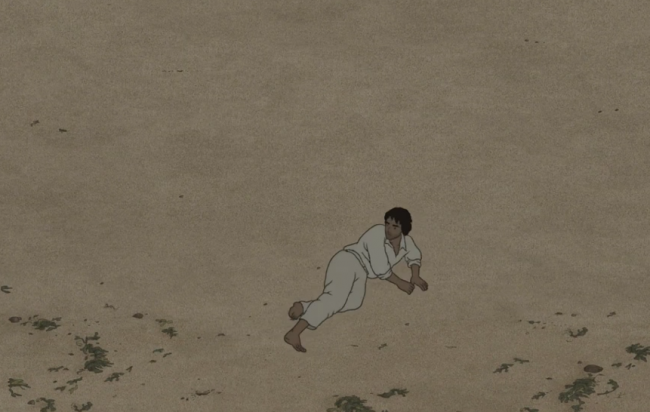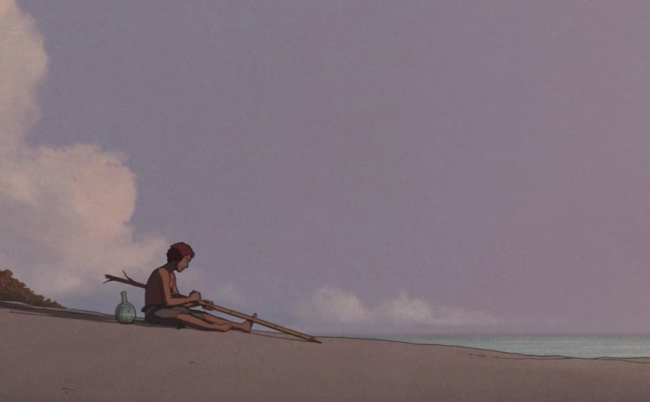
The Meaning of The Red Turtle: Nature’s Beautiful Chaos
The Red Turtle is an animated film about a man seemingly shipwrecked on a deserted island who meets a large red turtle that has profound effect of what happens next. Why? What does it mean? Let’s explore what we can learn from this breathtaking parable on life itself.
The Red Turtle is a film co-produced by Studio Ghibli, a Japanese anime studio best associated with anime about children and fantastical creatures. Written and directed by Dutch-British animator Michaël Dudok de Wit, it has earned widespread acclaim for its beautiful art style, gripping story, and deeply moving experience. While it has a number of obvious themes, it has reached people in surprising ways, its symbolism a great source of inspiration and interpretation. Curious as to what it all means? Read on, but be warned, major spoilers ahead.
THE STORY: It begins with a man alone in the open roiling sea, tossed about until he is swept ashore on a small deserted island where he finds fresh water, food, and a safe haven yet yearns to be be free of it, constantly building rafts on which he might escape. A large red sea turtle scuttles his bamboo crafts each and every time, forcing him back to the beach. When the turtle herself comes ashore one day, angered by her refusal to let him leave, the Man beats her and then flips her on her shell, exposing her to the sun’s heat, eventually killing her.
READ MORE: A full review of the Studio Ghibli produced film The Red Turtle
From her shell though emerges a beautiful young woman, whom the Man takes to immediately, and in time shares great love. They have a baby, a boy who is curious and as he grows, rebellious, eager to explore, wanting to discover what lies beyond the horizon. It breaks his parent’s hearts, even if there is inevitability to his actions. As time passes, the Man and Woman soon succumb to their natural ends as she retakes the form of a turtle and returns to the sea.

WHAT IT MEANS: Let’s start with the larger theme, which is our relationship with nature herself. We begin with a young man cast to the sea, though we don’t see how. Representing Mankind, he is the untamed and directionless figure, taken by the swells and whim of the waves. Delivered to the shores of safety, he is frightened but more so curious, an explorer, his baser needs propelling him inward to seek out sustenance. The island is not paradise though it is home.
And yet, not. Man strives to break from it. In numerous attempts, he builds rafts from the bamboo groves inland and sets about to sail away back to an unseen place beyond the horizon (a theme revisited later). He manages to get only so far though as he meets with disaster each time by the aggressive red turtle who crushes the beams and sinks his crafts.
But why? To understand the turtle metaphorically, we must understand the turtle in reality, a species of many varieties that lives in the great vastness of the sea only to return to land every few years to lay eggs, of which, from large numbers laid, only a very small percentage survive. Noble and long-lived, they are a symbol of wisdom, knowledge, longevity, peace, strength, creativity and much more to many cultures around the world.

With that said, of all the sea creatures in the ocean, it makes sense then that the form Mother Nature would take in the story is that of a sea turtle. What’s important however is that in destroying the rafts, she is not destroying Man, but in fact, very much the opposite, securing his survival on the nearby island, to which she had provided all he needs. Except one.
What he needs most is companionship, and in turn, descendants, and legacy. By coming ashore, a struggle that, much like reality, exhausts her, the turtle sacrifices herself, like the parallel creature of reality, laying the eggs of the future. But what we see is Man’s rejection of and misunderstanding of her value as he beats her head with a bamboo shaft and then quite cruelly tips her upside down where her underbelly bakes in the sun. It’s a harrowing sequence.

This action represents Man’s short-sightedness, his impulse to defend the immediate rather than consider the longterm. The red turtle has purpose on the beach but is also highly vulnerable, something the Man exploits, and yet there is a sense she recognizes this, and we see smaller themes form as the next phase begins. There is untapped power within nature that Man releases, and there is a feeling perhaps that the bond between the two begins with her metamorphosis, something only triggered by his actions.
Once the turtle dies, its shell cracks, and the Man is stunned find that within the hollows of the dead turtle is a young woman, herself unconscious and weakened. She is the real partner, a creator of life, and a tamer of his wilds. While she lays nestled in the broken shell, the Man takes to protecting her, and we see a shift in attitude where nature is once again held with care.
READ MORE: A 5 Frames tribute to Studio Ghibli animated films
As the giver and bearer of life, she inspires Man’s maturity per se, to be better able to provide for and protect. The story then splinters, cleaving to tell the story of the human experience while continuing its parable on Man and nature. We see some familiar moments of a couple in love, bonding, sharing, and having a child. The island comes to represent the challenges of their (of our) responsibilities in doing so, but also the great emotional fluxes of what it means to raise and prepare the next generation to replace us.
What we initially believed true, that he was shipwrecked at the start, has changed. The Man left his home, an island far away, just like now, as his own son will do.
Of the many visual metaphors, most compelling is a deep hole atop one of the island cliffs that once fallen into is only escapable by committing to diving below the water at the bottom and wriggling through a small crevice to the open ocean on the other side. It is dangerous and wrought with peril. Both the Man and his son accidentally fall into that pool with both braving the process and coming through the challenge, dare I say, birthed to become better men. The point for each is that to make it, one must do it alone, first the Man because he is isolated, and second, the child when his mother teaches him how. The obstacle represents not only the tenacity of who we are, but also the importance of parental guidance and its impact on those who will carry that knowledge forward.

As that boy grows to manhood, there is unease and eagerness about him. Curious and hungry to learn, his eyes are always on the horizon, a reflection of his father. The island is his home, but we suspect now that it won’t be for long, and there comes a cyclical feel to the story as he is now the same age as his father when he arrived. What we initially believed true, that he was shipwrecked at the start, has changed. The Man left his home, an island far away, just like now, as his own son will do; the cycle of life told in patches of land on a giant sea. The turbulent emotions that surround the family concerning this comes in the form of a tsunami that washes over the island with great ferocity, sweeping it nearly desolate, ravaged, and empty of its once lush grandeur. For the young man, there is nothing left to keep him. The message is clear. It’s time to go.
Meanwhile, we’ve seen the boy befriend his own sea turtles, a pair of green creatures who seem connected with him from when he was a small boy and whom both help carry him out to his destiny. The older man has taught his son well, Man’s next generation partnered with nature now in better and more compatible ways, and it will be him who shall carry that message and practice to those he meets on his adventure as an adult.

The film ends with the Man and the Woman passing of old age, alone together on the island, their time and contribution over. She transforms back into a giant red turtle and leaves him on the shore as she crawls back to the waves and disappears, her journey perhaps starting once again. Dudok de Wit closes a powerful story that challenges, one that is clearly environmental but more so deeply human, a chaotic tale that tasks us with understanding our place in the nature of things while at the same time telling the very story of who we are and what it means to be us.
